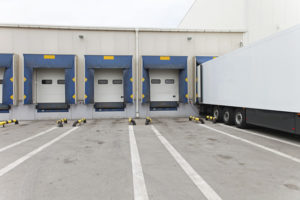Preventing accidents and injuries in the workplace is always a priority, no matter what industry you’re in. Loading dock area can be high risk for potential accidents if proper safety measures are not taken. Luckily, there are several procedures you can incorporate to greatly increase the safety of everyone. 
Repairing your loading dock equipment is essential in ensuring your loading dock area is safe. If you’re looking for top quality repairs and equipment in Toronto, check out our loading dock equipment options. Keep reading to find out how to reduce the risk of accidents at loading docks.
Loading Dock Hazards
Loading dock equipment that is in poor condition is a safety risk and needs to be fixed immediately, before it becomes a bigger problem. Some conditions that are safety warning signs include:
- congestion of storage or traffic
- poor lighting
- uneven surfaces
- minimal safety markings/signage
- lack of automated safety devices
- hazards with trucks, doors, rolling conveyors, lifting devices, and other mobile equipment
Along with daily inspections by staff, it’s essential to have a professional perform a planned maintenance service inspection to ensure that the equipment is safe, and to adhere to Ministry regulations.
Controlling Hazards
Clear signage and throughways need to be established to avoid any potential hazards. This includes:
- Routes for safe pedestrian traffic must be clearly marked around loading dock areas
- Reduce the storage and clutter around the loading dock area, giving clear visibility to all occupants.
- The materials being used/transported cannot exceed the weight limit of the forklifts or the dock levelers
- Add automated safety/communication devices to your equipment to communicate effectively, such as traffic lights, trailer lighting and safe sequence of operation.
Repair or Replace Worn Equipment
Loading Dock equipment needs to be working as per original manufacturer’s specifications or you risk several potential hazards.
Examples of these hazards include;
- overhead door failure from old cables, springs and related wear-items
- loading dock fatigue due to overloading and worn lifting components and related parts
- worn shelters or dock seals that allow water and debris to be able to enter into the work area causing slippery floors or damaging product.
During the winter, make sure your weather-seals around your docks and doors are working properly and you should consider adding extra insulation to your loading dock areas or add air-barriers; this will keep your employees comfortable from cold drafts during shipments.
Loading and Unloading Procedures
There are several safety procedures you should be following when loading and unloading trucks. These include:
- Ensure proper lifting techniques are used to prevent injury.
- Place physical barriers or clear signage around the area and at dock edges to prevent falls.
- Make sure unauthorized persons are not in or around the loading dock area
- Automate your equipment with the correct sequence of operation as much as possible to prevent human error.








